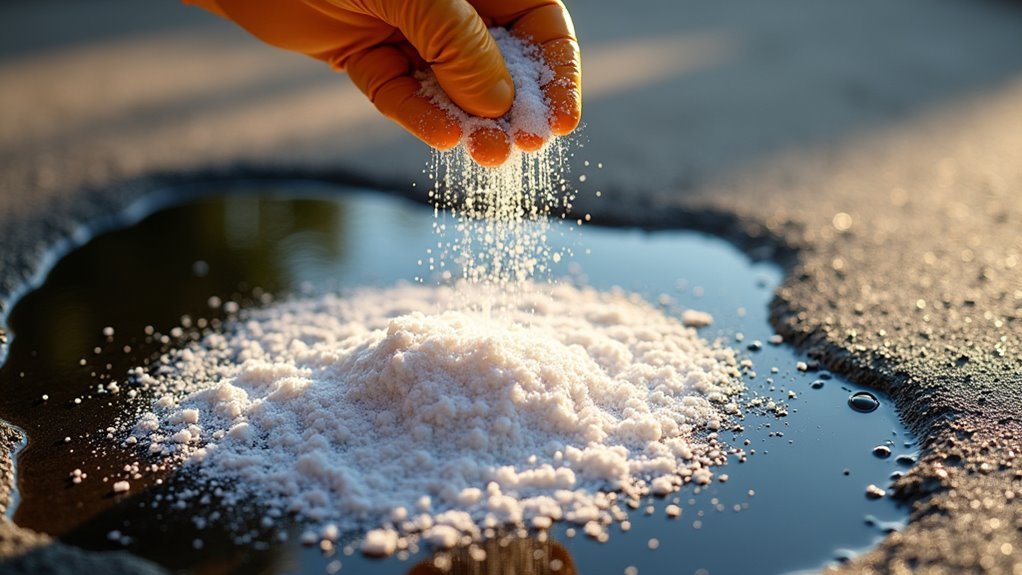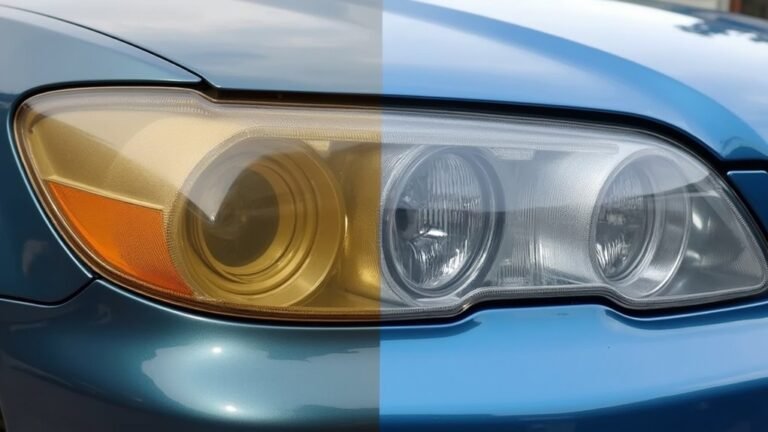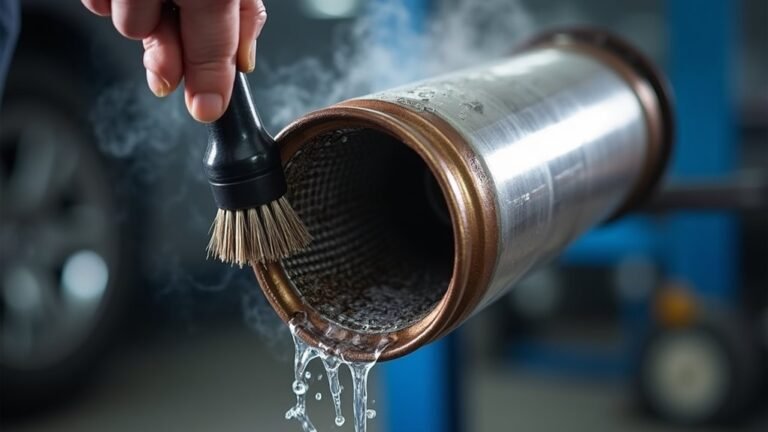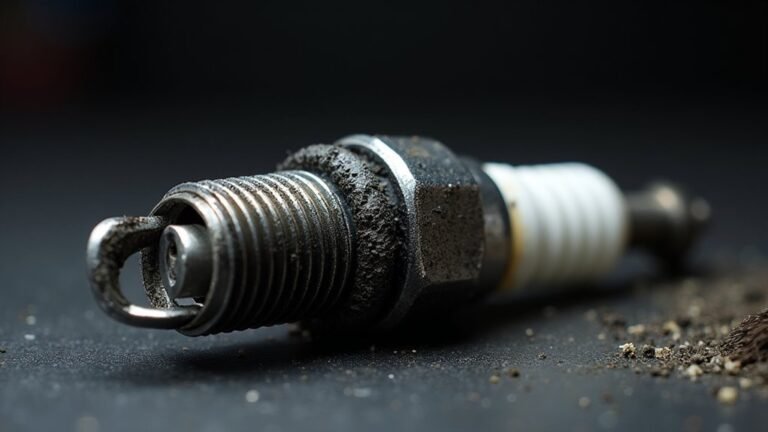Oil spills under cars are a common problem that can happen to anyone. Whether it’s in your garage or driveway, these dark puddles aren’t just ugly – they can leave lasting stains on concrete if you don’t clean them up quickly. Oil is tricky to clean because it soaks into surfaces fast, but there are simple ways to deal with it.
According to Mike Pennington, Director of Training at Meguiar’s, “The key to removing oil stains is treating them as soon as possible. The longer you wait, the harder they become to remove.”
Taking care of oil spills right away can prevent permanent damage and keep your parking area looking clean. Most importantly, cleaning up oil spills helps protect the environment and keeps your family and pets safe. Let’s explore how to handle these messy situations…
Act Fast; Prevent Staining

When you spot an oil spill from your car, don’t waste a second!
Time really is vital here.
Oil seeps into concrete within minutes, so immediate action prevents permanent staining.
Oil penetrates concrete quickly – act fast to save your driveway from permanent damage.
Grab kitty litter or sand to soak up the spill right away.
Once it’s absorbed, dispose of the material properly, then clean with a degreaser.
You might need to repeat this process for stubborn spots. Proper knowledge and tools simplify the cleaning process.
##
We’ll now look at what you should and shouldn’t do when tackling car oil spills, as well as the specific steps to follow.
I think everyone’s faced that moment of panic seeing oil dripping under their car, but with the right approach, cleanup doesn’t have to be overwhelming. Regular maintenance of your oil system, including cleaning the filter, can help prevent spills and leaks in the first place.
Let’s walk through the process together and wrap up with some final thoughts on keeping your garage or driveway oil-free.
Things to Do When Cleaning Car oil
When tackling a car oil spill or stain, quick action and proper technique are essential to prevent permanent damage and environmental hazards.
Whether the oil spill happened in your garage, driveway, or on another surface, a systematic approach using common household items can effectively remove the unsightly stain and prevent it from spreading further.
- Contain the spill immediately – Use absorbent materials like kitty litter, sand, or commercial oil absorbents to prevent the oil from spreading and creating a slip hazard.
- Apply absorbent material generously – Sprinkle sawdust, clay kitty litter, or specialized oil-absorbing products over the entire stain and allow 24-48 hours of contact time.
- Break down the oil – Apply a degreasing solution such as dish soap and water, WD-40, or laundry detergent to help break the oil’s bond with the surface.
- Scrub thoroughly – Use a wire brush in circular motions with firm pressure to work the cleaning solution into the stained area.
- Rinse completely – Use a pressure washer or garden hose to thoroughly rinse away all cleaning solutions and loosened oil residue.
- Repeat if necessary – For stubborn stains, repeat the cleaning process or consider professional help from services like Rainbow Restoration if DIY methods aren’t sufficient.
Things to Avoid When Cleaning Car oil
When dealing with car oil spills, proper cleanup techniques are essential to prevent permanent damage and environmental hazards.
The wrong approach can make the situation worse, leading to stained surfaces, environmental contamination, or even personal injury.
Following correct procedures guarantees effective oil removal while protecting both your property and the ecosystem.
- Delaying cleanup – Oil begins penetrating surfaces within minutes, causing permanent stains and increasing environmental risks; address spills immediately to prevent deeper absorption.
- Using water alone – Water spreads oil rather than absorbing it, creating larger contaminated areas and making the cleanup more difficult; always use appropriate absorbent materials first.
- Improper disposal of materials – Throwing oil-soaked absorbents in regular trash violates environmental regulations and can contaminate soil and waterways; dispose of them at designated hazardous waste facilities.
- Aggressive scrubbing of surfaces – Excessive force or improper tools can damage concrete and other surfaces, potentially etching the material and requiring multiple cleanup attempts; use gentle, repeated applications instead.
- Applying unapproved chemicals – Products like bleach or ammonia aren’t suitable for oil cleanup and may create toxic fumes or dangerous chemical reactions with oil residues; stick to recommended degreasers and cleaners.
Steps
Oil spills from your vehicle can create unsightly stains on your driveway or garage floor while posing environmental hazards if not properly addressed.
Cleaning up car oil effectively requires quick action and the right approach to prevent permanent damage to concrete surfaces and potential contamination of surrounding soil or water systems.
Step 1: Immediately contain the spill by applying absorbent materials such as kitty litter, sand, or commercial oil absorbents directly over the affected area.
Step 2: Allow the absorbent material to sit for 24-48 hours to fully draw out the oil from the surface.
Step 3: Sweep up the oil-soaked absorbent material and dispose of it properly according to local regulations for hazardous waste.
Step 4: Create a cleaning solution by mixing liquid dish soap with warm water, or prepare an alternative cleaning agent using WD-40, dry laundry detergent, or acetone mixed with an absorbent.
Step 5: Apply the cleaning solution generously to the stained area, allowing it to penetrate for 15-20 minutes.
Step 6: Scrub the area vigorously using a wire brush in circular motions to work the solution into the concrete.
Step 7: Rinse the area thoroughly with clean water or a pressure washer to remove all cleaning solution and loosened oil.
Step 8: Repeat steps 4-7 if necessary for stubborn stains that don’t completely lift with the first attempt.
Step 9: For persistent stains that resist home remedies, contact professional cleaning services like Rainbow Restoration at (855) 724-6269 for specialized treatment.
Final Thoughts
Tackling car oil spills requires diligence and proper technique to guarantee both effective cleanup and environmental responsibility. We always recommend wearing protective gear throughout the process – your safety matters!
Remember to dispose of absorbents properly at recycling centers, as engine oil can be recycled.
If you’ve tried multiple times without success, perhaps it’s time to call professionals like Rainbow Restoration.
Regular vehicle maintenance is, I think, your best defense against future spills.
##

Tackling car oil spills promptly is your best defense against permanent damage.
From cat litter and dish soap to commercial degreasers, you have multiple options to address fresh oil stains on your driveway or garage floor.
Remember that the key to successful removal is quick action, proper absorption, and thorough cleaning.
For those stubborn stains that won’t budge despite your best efforts, don’t hesitate to call in professionals.
Rainbow Restoration specialists have the expertise and specialized solutions to handle even the most resistant oil stains.
You can easily schedule an appointment online by entering your Zip/Postal code on their website or call them directly at (855) 724-6269 for personalized assistance.
Whether you’re dealing with a small drip or a significant spill, taking action quickly will protect your concrete surfaces, prevent hazardous conditions, and keep your property looking its best.
Additionally, regular maintenance routines can help prevent future issues with oil stains.
Don’t let oil stains become a permanent fixture—with the right approach, you can restore your surfaces and prevent future problems.






